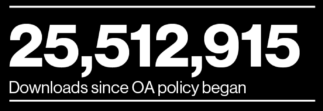 In the five years (to the day!) since MIT faculty unanimously voted to pass the MIT Faculty Open Access Policy, dozens of other colleges and universities in North America have followed suit. In 2013 alone, nine institutions, or schools within institutions, committed to open access policies. These include Oregon State University, Wellesley College, the University of Rhode Island, Caltech, Bryn Mawr, and one of the largest public research universities in the world, the University of California. Faculty members at UC, which has 10 campuses and more than 8,000 faculty, receive about 8% of all research funding in the United States.
In the five years (to the day!) since MIT faculty unanimously voted to pass the MIT Faculty Open Access Policy, dozens of other colleges and universities in North America have followed suit. In 2013 alone, nine institutions, or schools within institutions, committed to open access policies. These include Oregon State University, Wellesley College, the University of Rhode Island, Caltech, Bryn Mawr, and one of the largest public research universities in the world, the University of California. Faculty members at UC, which has 10 campuses and more than 8,000 faculty, receive about 8% of all research funding in the United States.
“Scholars everywhere owe deep thanks to the UC faculty,” wrote Peter Suber, director of the Harvard Office for Scholarly Communication, when the UC policy passed in July 2013. “[The policy] will increase the momentum for other universities to adopt their own OA policies. And it will prove that even the largest and most complex universities can still adopt OA policies by faculty vote.”
The recent policies all use language similar to MIT and Harvard, whose Faculty of Arts and Sciences passed the first OA policy in North America in 2008. They are permission based, which means faculty authors give their university a license to make articles freely available in an online repository like DSpace. In other words, OA policies like these shift the default to open access. As noted by the UC Office of the Academic Senate, “The adoption of this policy across the UC system also signals to scholarly publishers that open access, in terms defined by faculty and not by publishers, must be part of any future scholarly publishing system.”
More information:

